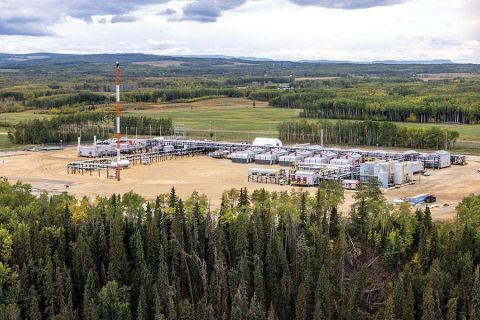
HOUSTON -- Improved drilling efficiencies are real and should continue for several more years. That was the conclusion of David Pursell, managing director, head of securities, Tudor Pickering Holt & Co. Pursell spoke at Hart Energy’s Energy Capital Conference in Houston recently.
Actual counting of rigs is becoming less important as an industry metric, and focus is shifting to how many wells are being drilled. As efficiency increases, what becomes significant is the number of wells drilled per rig year. “What we’re seeing in all of the key shale plays — where the majority of the horizontal wells are drilled — are significant and continued improvements in days to drill,” said Pursell. Days are being shaved off drilling times even in such mature plays as the Barnett and Fayetteville. The efficiency increases are due to improved drilling techniques, combinations of bit and mud systems, and better rigs.
However, unless rig count trends move higher, the U.S. land rig fleet will soon outstrip demand. New rigs continue to come on the market: Helmerich & Payne Inc., Patterson-UTI Drilling Co. and Nabors Industries are each building new rigs, and Tudor Pickering Holt forecasts that some 55 new AC (alternating current) rigs will be added to the onshore U.S. fleet this year. In contrast to older-style mechanical rigs, AC rigs have automated drilling controls, optimized torque and other features that generally drill a better well bore more quickly.
“Even high-quality rigs are soon going to be over capacity. Not only are the lower-capability rigs under-utilized, there’s not 100% utilization in AC rigs or the higher-capability rigs,” he said. Currently, some 265 mechanical-style rigs that are marketable are not working, and about 50 AC rigs that are marketable are not working. These latter are likely lower horsepower, older AC rigs.
One type of rig is defying the trend of steady to lower utilization. Rigs with walking capacity — both in the low-capability and high-capability categories — are seeing growing use even as overall horizontal rig counts have essentially flat lined during the past year and a half at some 1,100 units. That’s thanks to a trend toward more pad drilling. “What’s happening is that operators need rigs that help them drill the well faster, but more and more they need rigs that help them move and change locations more quickly. Both of these things matter,” said Pursell.
What is of growing interest now to industry analysts is the trend toward pad drilling, and speculation abounds about the scale of additional efficiencies that can be wrung out of the drilling process. Pad drilling offers clear efficiencies on rig moves, and its impact on spud-to-spud days will be significant. The size of the pads and the number of wells per pad will be crucial factors in the next stages of onshore development.
“We’re watching what happens with pad drilling,” he said.
Photo by Bloomberg.
Recommended Reading
E&P Highlights: Sept. 30, 2024
2024-09-30 - Here’s a roundup of the latest E&P headlines, including concessions awarded in the Middle East and updates following Hurricane Helene.
E&P Highlights: Nov. 11, 2024
2024-11-11 - Here’s a roundup of the latest E&P headlines, including Equinor’s acquisition of a stake in a major project and a collaboration between oilfield service companies.
APA, TotalEnergies Aim for 'New Dawn' in Suriname with Massive GranMorgu Project
2024-10-01 - APA Corp. and TotalEnergies announced a $10.5 billion final investment decision for the GranMorgu project located offshore Suriname in Block 58. First production to come from a 220,000 bbl/d FPSO is slated to flow in 2028.
E&P Highlights: Oct. 28, 2024
2024-10-28 - Here’s a roundup of the latest E&P headlines, including a new field coming onstream and an oilfield service provider unveiling new technology.
With Montney Production Set to Grow, US E&Ps Seize Opportunities
2024-10-02 - Canada’s Montney Shale play has already attracted U.S. companies Ovintiv, Murphy and ConocoPhillips while others, including private equity firms, continue to weigh their options.
Comments
Add new comment
This conversation is moderated according to Hart Energy community rules. Please read the rules before joining the discussion. If you’re experiencing any technical problems, please contact our customer care team.





